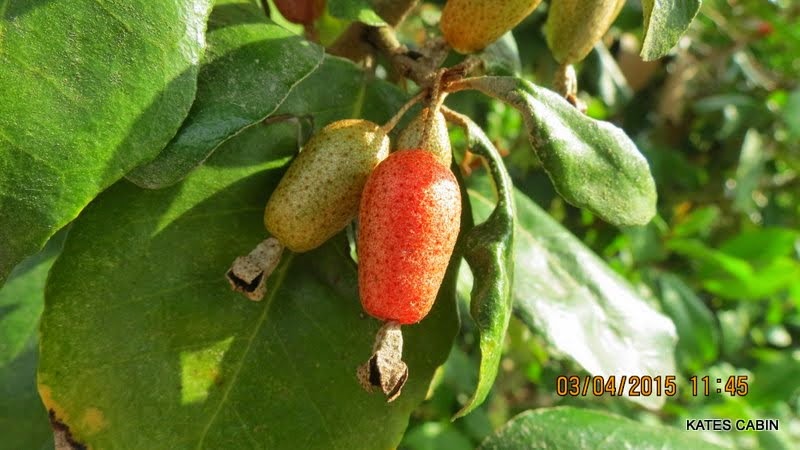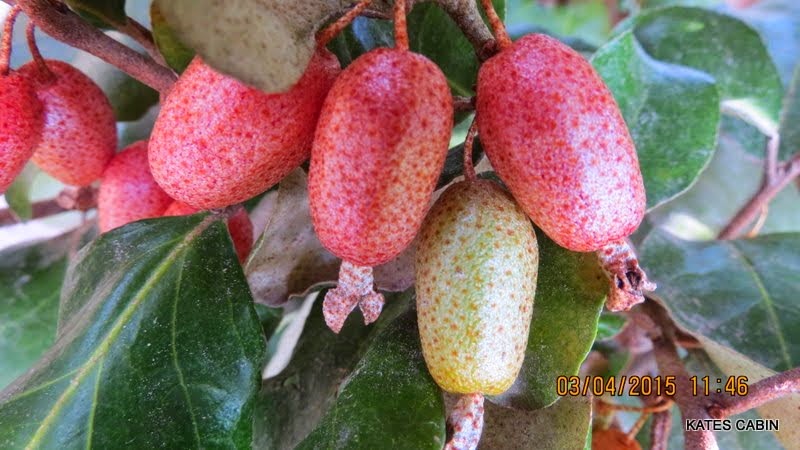
Hi Everybody!!
Today's photostudy will introduce you to the American Silverberry Bush with close ups of the yummy drupes on my plant. In this location, the large shrub flowers in late December with intoxicating smells of cinnamon wafting through the air. The tiny,sweet flowers attract winter bees, and after pollination, the tiny fruits appear. The ripe red fruits are not very big, but large on flavor, similar to lemon sugar. Jelly or wine can be made, but I prefer to just pop them in my mouth, then spit the seed out in a bowl of water! Dry the seeds in the sun, then plant for new bushes. This is a good, hardy shrub for any setting. Enjoy!


Link to G+ Photo Album:
https://plus.google.com/u/0/photos/117645114459863049265/albums/6123944840890542337









Buzzard hanging out on the creek

https://en.wikipedia.org/wiki/Elaeagnus
Elaeagnus /ˌɛliːˈæɡnəs/,[1] silverberry or oleaster, is a genus of about 50–70 species of flowering plants in the family Elaeagnaceae.
| Elaeagnus | |
|---|---|
 | |
| Elaeagnus commutata | |
| Scientific classification | |
| Kingdom: | Plantae |
| (unranked): | Angiosperms |
| (unranked): | Eudicots |
| (unranked): | Rosids |
| Order: | Rosales |
| Family: | Elaeagnaceae |
| Genus: | Elaeagnus |
Description[edit]
Elaeagnus plants are deciduous or evergreen shrubs or small trees. The alternate leaves and the shoots are usually covered with tiny silvery to brownish scales, giving the plants a whitish to grey-brown colour from a distance. The flowers are small, with a four-lobed calyx and no petals; they are often fragrant. The fruit is a fleshy drupe containing a single seed; it is edible in many species. Several species are cultivated for their fruit, including E. angustifolia, E. umbellata and E. multiflora (gumi).
Berries from a large-fruited cultivar
Elaeagnus commutata (American silverberry or Wolf-willow), is a species of Elaeagnus native to western and boreal North America, from southern Alaska through British Columbia east to Quebec, south to Utah, and across the upper Midwestern United States to South Dakota and western Minnesota.[1][2] It typically grows on dry to moist sandy and gravel soils in steppes, meadows or woodland edges.[3]
These plants are shrubs or small trees growing to 1–4 m tall. The leaves are broad lanceolate, 2–7 cm long, silvery on both sides with dense small white scales. The fragrant flowers are yellow, with a four-lobed corolla 6–14 mm long. The fruits are ovoid drupes 9–12 mm long, also covered in silvery scales. The fruit pulp is floury in texture, and surrounds the single seed.[3]
The species is cultivated as an ornamental plant for its silvery foliage.
https://en.wikipedia.org/wiki/Drupe
In botany, a drupe (or stone fruit) is an indehiscent fruit in which an outer fleshy part (exocarp, or skin; and mesocarp, or flesh) surrounds a shell (the pit, stone, or pyrene) of hardened endocarp with a seed (kernel) inside. These fruits usually develop from a single carpel, and mostly fromflowers with superior ovaries (polypyrenous drupes are exceptions). The definitive characteristic of a drupe is that the hard, lignified stone (or pit) is derived from the ovary wall of the flower. In an aggregate fruit composed of small, individual drupes, each individual is termed a drupelet.
Other fleshy fruits may have a stony enclosure that comes from the seed coat surrounding the seed, but such fruits are not drupes.
Some flowering plants that produce drupes are coffee, jujube, mango, olive, most palms (including date, sabal, coconut and oil palms), pistachio,white sapote, and all members of the genus Prunus, including the almond (in which the mesocarp is somewhat leathery), apricot, cherry,damson, nectarine, peach, and plum.

Link to G+ Photo Album:
https://plus.google.com/u/0/photos/117645114459863049265/albums/6123954503391070369



...this is brendasue signing off from Rainbow Creek. See you next time!

O+O



Hey Thanks for sharing this blog its very helpful to implement in our work.
ReplyDeleteRegards
LANDSCAPE COMPANY IN MADHYA PRADESH